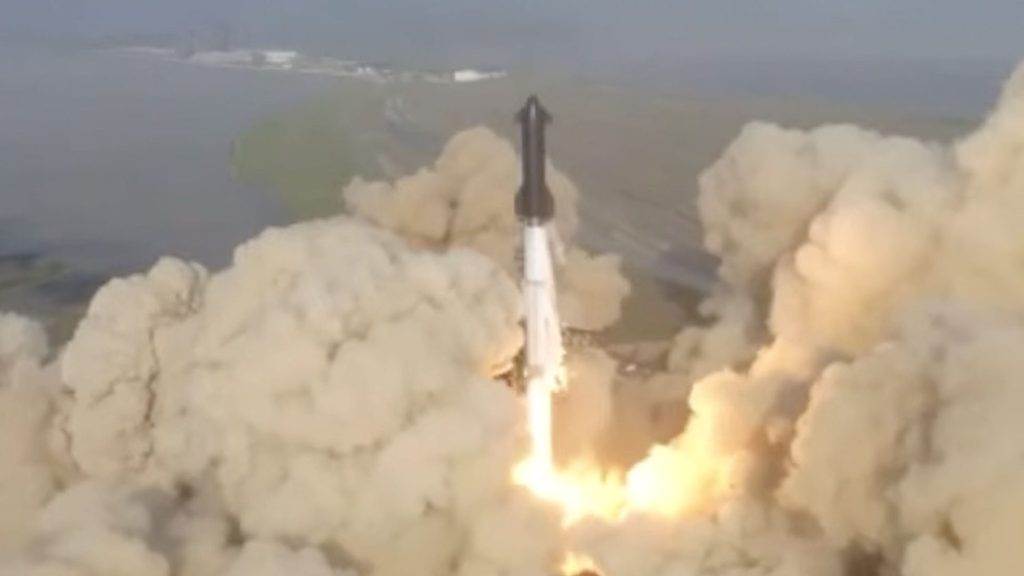Test Flight Paves the Way for the Transformation of Human Spaceflight
The National Space Society congratulates SpaceX on a partially successful test flight of its new Starship/Super Heavy reusable rocket, the most powerful ever launched.
Shortly after 8 a.m. Central Time on April 20, the enormous booster lifted off from the SpaceX Starbase facility in Boca Chica, Texas. While intended for a roughly 90-minute orbital flight, the test ended prematurely as the vehicle started to tumble and was destroyed by the Flight Termination System. Starship/Super Heavy was launched without a crew and flew its short mission robotically.
Dale Skran, NSS COO said, “It is hard to exaggerate the significance of the first flight test of the SpaceX Starship/Super Heavy. Unlike the Falcon 9, which arguably represents the refinement and perfection of previously demonstrated technology, virtually every aspect of Starship is a technology first. And the most significant first surely lies in the planned total reusability of the Starship/Super Heavy system. While we wish it had been completely successful, the fact that the vehicle cleared the launch tower and completed the early stages of its flight is a major milestone. We look forward to SpaceX’s next test flight for the Starship system, which will ultimately be the first truly fully reusable launch vehicle.”
The Starship system was originally conceived as early as 2005 when SpaceX founder Elon Musk spoke of an enormous rocket that would dwarf NASA’s Saturn V of the 1960s, with far more lifting power and the ability to be completely reusable. Over the years, the design parameters changed multiple times, as did the name of the mammoth spacecraft, but the goals remained the same: routine and affordable access to space, and ultimately, the human settlement of Mars.
Starship is the upper stage and stands 164 feet tall, and the Super Heavy Booster is 226 feet tall, with a combined height of 390 feet, dwarfing the Apollo program’s Saturn V Moon rocket that stood at 363 feet. With a liftoff thrust of almost 17 million pounds, it will be capable of lifting 150 tons to low-Earth orbit and, with orbital refueling from the proposed Starship refueling tanker, will be able to deliver almost that much to the Moon. A lunar derivative of Starship has been chosen by NASA to land the first crew to return to the Moon since 1972 via the Artemis III flight, scheduled for some time after 2025.
“It is not too much to say that today is a step toward the dawn of the real age of space, the age in which the resources of space will richly benefit all of humanity. Once this launch system is successful, nothing will be the same,” opined Isaac Arthur, NSS President.
“Although intended to enable the construction of the first city on Mars, and under contract to NASA to return American astronauts to the lunar surface, the refuelable Starship promises bigger orbital telescopes and more capable planetary probes than anything yet conceived,” added Karlton Johnson, Chairman of the NSS Board of Governors. “We congratulate SpaceX on their partially successful launch attempt today.”
Starship is designed to be rapidly reusable and SpaceX intends to build many of them quickly and affordably, with launch costs significantly less than traditional rockets and far below the cost of NASA’s Space Launch System. Musk’s goal is to provide a ready and affordable means to move people and cargo to Earth orbit, the Moon, and beyond in a routine manner.
If successful in scale, the Starship is a key component to achieving the NSS Roadmap to Space Settlement and will revolutionize spaceflight and the development of human outposts and settlements in orbit, on the Moon, and ultimately on Mars, Musk’s long-term goal. Further test flights will depart from Texas in short order, with operational launches from Kennedy Space Center in Florida, where NSS has its headquarters.




















1 thought on “The National Space Society Cheers SpaceX Starship Launch Test”
Congratulations SpaceX. Good luck with the next Starship/Super Heavy test flight.